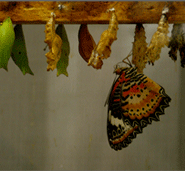Olive green wallpaper with dusky pink flowers wraps the bedroom wall. The house had no blueprint, and the ceilings slope in a little. Books lie stacked on a shelf on one corner, and a dresser with a blank mirror on another. The room is still dark. Outside, in the kitchen there are recipe books, spices and oven mits perched on a table. On the stove, a pot of stew boils. White curtains with little red roses part ways for the sunlight to stream through. On the half doors at the entry hangs an irregular, wooden plaque: Home Sweet Home.
The Renaissance saw the emergence of wallpaper as an all-encompassing, insulating aspect that made rooms appear instantly regal and homely. Thukral and Tagra use this wallpaper as a signature aesthetic: to parody wallpaper and to parody art, to make synthetic subjects faux-pretty, to set a scene for a dysfunctional imagination set free into a society obsessed with concealment.
Part of a larger AIDS awareness campaign is their 2007 series of oils and acrylics on canvas, ‘Stop Think and Go’ and ‘Let's Play Safe’, where T & T paint media icons with the instructional condom-wearing gesture superimposed onto a background of wallpaper, which fragments the bodies of those just about to make love. The context is imperative to the content, they seem to say.
In ‘I Like My Man Covered’, the bed sheet becomes a kind of wallpaper, rumpled and creased sheets, the leaves of the white flowers blending seamlessly into ghostly icons of birth-control, like nature bleeding into human life.
These utopic scenes of flowers and bodies are broken with the plastic of the condoms and the elastic of the underwear. T & T create an atmosphere of love about to happen: that moment just preceding the climax, and the layers that inhibit us from arriving there. The condom and the underwear become, thus, not just physical impediments to Total Intimacy, but symbolic and artificial structures that prevent One from being completed by Another, from being swallowed by our wallpapers and our bed sheets.
The thing that keeps us from this Complete Unity is our inner life. No faces or expressions are revealed, these bodies are merely bodies, medicated still-lifes left alone in their individual, private, spiritual worlds of real togetherness.
T & T, the close-as-kin duo, are stylistically unified, yet evoke an inherent duality of ideas, simultaneously reinforcing and subverting their pastiche of subjects. They employ the methods of fine-art painting to parody pop culture, they employ the icons of the contemporary communication to comment on how we have distanced from ourselves just as they employ the sheet to reveal.
Despite the aerial perspective, their representations are left morally ambiguous, forcing us to wonder whether they mean to address AIDS and our population disorder or if they are indeed questioning the intellectual loss that arises with our wallpapered ‘Home Sweet Home’. One protective sheath prevents corporeal disease, the other (the one we create in our minds) prevents us from healing. How many layers must we create between ourselves and our environment in order to be really ‘safe’? Can we be with another person and still retain an individual identity or must we necessarily be overwhelmed and erased by our landscape? How to we protect our inner lives from being enveloped by love? And eventually, how do we protect our inner lives from ourselves?
The light that filters through the windows is softer now and falls on the whistling wallpaper, erasing parts of it in shadow and illuminating others in the pink hue of a setting sun. The stew is ready and the table is set. The forks and spoons are silver, but they bend like plastic. The bedroom door is open. There is nobody here.
Jiten Thukral was born in 1976 and lives in New Delhi.
Sumir Tagra was born in 1979 and lives in New Delhi.
Himali Singh Soin is a writer living in Delhi.
Editor's Note.
The Aquarian, the water bearer, has long since been associated with the container that shapes otherwise liquid ideas. With Valentines Day right in the middle of the Aquarius sign, it is no wonder that the cup features so prominently amid the Great Poets' love melodies. A belief in the stars, a longing for a bond, and a desire to consume might be some roots to the idea of the cup of love.
Read MoreAlso in this issue
Illusion: Seeing Beyond Seeing
Meaning: In Search of Significance.
Melody: A Different Tune
Rhythm: Ordering Time









